Now in its 13th model year, Yamaha’s FJR1300A is the longest-lived sport-tourer on the market. That’s because it’s a good motorcycle—fast, smooth, comfortable, good-handling and reliable. Many long-distance records have fallen beneath its radial-shod wheels, including the mind-boggling 86-hour, 5645-mile Prudhoe Bay to Key West blast of John Ryan in 2009. A capable bike for sure, but in an era when a two-year-old smartphone is ready for “Antiques Roadshow,” it was time for another mid-cycle update.
Yamaha summoned me from the drab horrors of my everyday life to ride the re-worked 2013 FJR in Northern California’s wine country, and how could I refuse? The promise of 300-plus miles on great roads on an improved version of one of the best sport-tourers made was enough to keep me motivated through the short tech presentation.
Yamaha wanted us to know that market conditions have changed a little since the last update. ST buyers are slightly more affluent, slightly older—but also more frugal, demanding more versatility from their rides. So Yamaha wanted to improve comfort and convenience features, increase touring capability, make the bike feel lighter and more sporty and “offer the latest technology.”
The bike looks much the same as last years, but has a huge number of detail improvements. The motor gets new cylinders, ignition, rings, throttle bodies, as well as new traction control, exhaust and ECU settings. Styling is freshened up with new headlights, cowlings, side fairings, switchgear and instruments, and comfort and convenience is enhanced with a reworked lower-effort centerstand, cruise control, heated grips, new seat cover and windscreen. Handling is also improved with changes to suspension spring rates and damping as well as new OEM tires.
Three hundred miles is a pre-breakfast ride for many FJR owners, but it’s a lot for a two-day press event, as journalists need time for photography, Tweeting and lavish meals. But it was necessary to really get a feel for the myriad changes on the bike.
What I remember about the last FJR I rode (a 2009 automatic-clutch equipped bike, available only in Europe now) was a good-handling, comfortable bike with some turbulence from the windscreen and a slightly rough motor. Dirck recalls a stiff throttle return spring as well as the turbulence from his last ride.
After two days on a variety of roads—from divided superhighway to tight, bumpy two-laners—I can say the changes are noticeable and well done. The motor is better; it’s smoother and more responsive, with the choice of two mapping settings, Tour or Sport. Both settings offer full power, but Tour gets you there a little slower. Throttle response is great, with no abrupt surprises and a light return spring—even without the very good cruise control Dirck’s delicate wrist should remain cramp free.
Yamaha claims an increase of three horsepower and three ft.-lbs. of torque, but what I noticed was the smooth and abundant nature of the power delivery, which keeps the five-speed gearbox relevant. Second, third or fourth gear work fine on any kind of road, thanks to the massive amounts of torque and smoothed-out powerplant. Passing in fourth is fun, a taste of being a comic-book superhero. Fifth works well as a passing gear, too, but at a .929 ratio, is also a true overdrive, helping keep indicated fuel consumption in the mid to high 40s at steady throttle at 70 mph.* That should give the rider a 200-plus mile range from the 6.6-gallon tank (I was only able to get a little more than five gallons into the 2009 I tested—I didn’t have an opportunity to fuel the 2013 myself).
I don’t know if the suspension changes improve the bike, as we didn’t have a 2012 to compare, but the bike is still a great performer. It handles better and feels lighter than any 637-pound (Yamaha’s wet-weight claim, seven pounds less than the 2012) bike should, and kudos to Yamaha for making suspension adjustment easy—a lever adjusts rear spring rate from firm to soft, and front compression and rebound adjustments are all handled in the right 48mm fork leg. Aided by the specially developed Bridgestone BT-023F tires, the FJR turned easily and felt planted and secure, even on cold, slippery downhill turns. Nobody felt like testing the traction control, but it’s there, along with “unified” ABS brakes—useless until you need them, and then they’re worth everything you own.
Long-distance comfort is impressive. The two-position-adjustable seat, clad in a new seat cover with Nubuck-esque “high quality” side trim, is wide and supportive, though the foam started to feel unpleasantly hard after a few hours. The seating position is close to perfect, and the bars adjust fore and aft so you can get it perfect-er. The windscreen seems much improved—airflow is smoothed out, with less buffeting (Yamaha offers a taller, wider screen if it’s still too noisy for you) and it raises and lowers twice as fast as the old one. Plus, the screen stays in place when you remove the key, eliminating one tiny irritation.
Some improvements I (and many others, doubtless) would like to see haven’t materialized. While the new rider information display is data-packed and easy to use, there is no sound system or Bluetooth connectivity, something farkle-addled hypertourers like, along with portable-generator levels of alternator output (the FJR puts out 490 watts at 5000 rpm, leaving 325 watts of excess capacity, according to the Powerlet people, sufficient for most solo touring needs), and luggage capacity is reminiscent of the closets in Victorian houses—didn’t those people own more than three changes of clothes? At least Yamaha offers a man-sized 50-liter top case, complete with backrest to beef up your trousseau.
So while the lack of a total redesign after 12 model years may be a disappointment for some, Yamaha delivers on the original promise of the FJR—a light, sporty-feeling tourer you can ride like a sportbike. At an MSRP of $15,890, it’s just $300 more than last year and is cheaper and lighter (by a lot!) than Kawasaki’s Concours14, Honda’s ST1300 or BMW K1600GT. Good enough for another 13 years? Maybe not, but for sporty-touring it’s good enough for me and it’s probably good enough for you too.
*Yamaha claims 36 mpg based on EPA emissions info. Average reported fuel economy on Fuelly.com for FJR models is around 40.
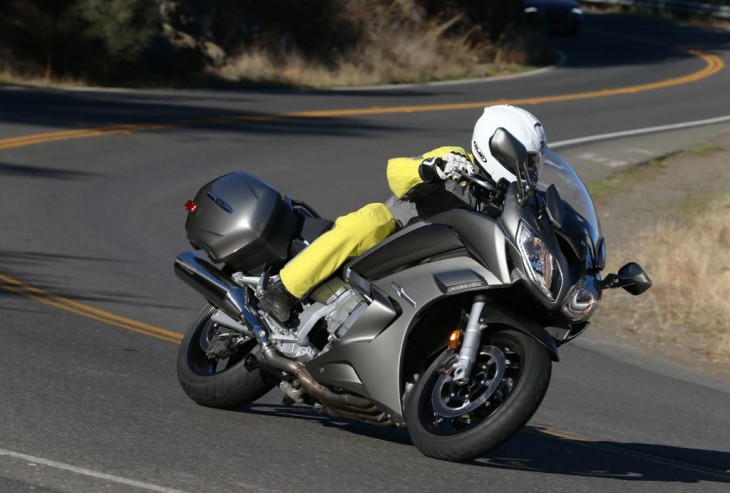
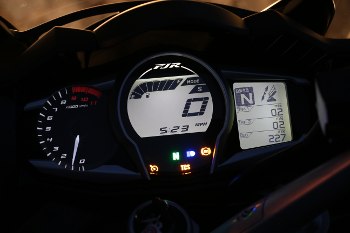
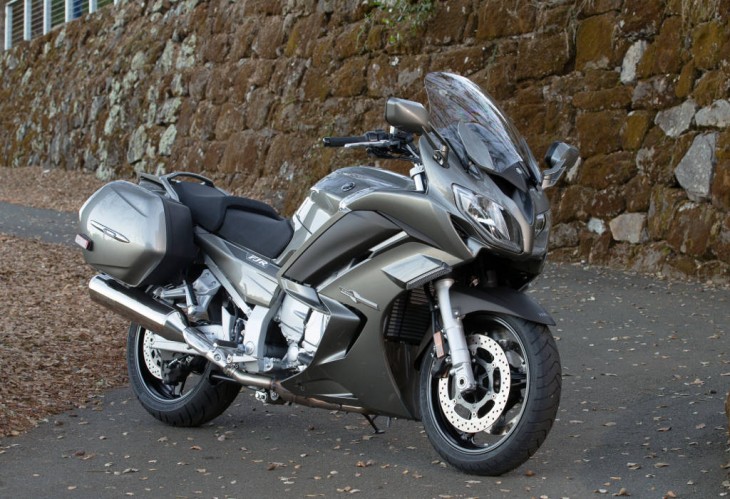
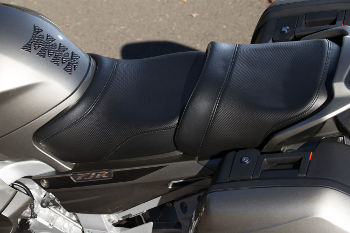
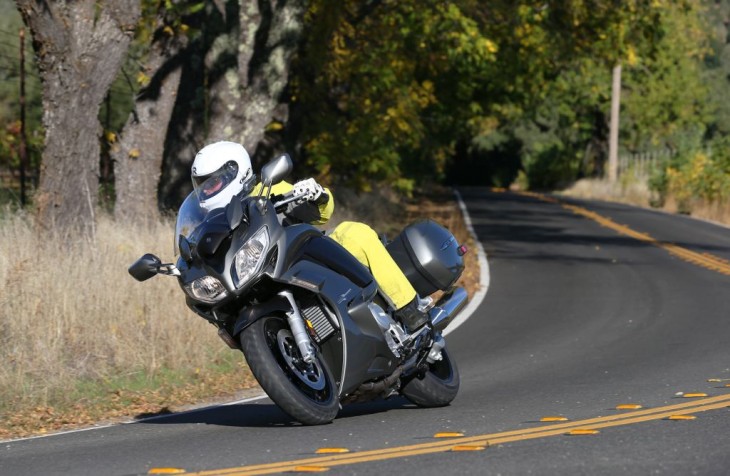






Always liked the design of this bike my only complaint in the sport tourer bikes is lack of a radio/stereo to kill the endless miles. BMW K1600 GT has one though
carl says: “radio/stereo — BMW K1600 GT has one…”
And the BMW K1600 GT weighs over 700 lbs. — how “sporty” is that..? :o(
Bummer about the lack of stereo. Wouldn’t it be cool if you could have a small device with all your music on it that you could operate with a remote control and have really good headphones that also worked to block out external noise?
Oh wait, you can get all that, really cheap too.
God, prices keep going up. Sheesh, I remember when the FJR was,what, $10,000?
We’re living in deflationary times and the last 12 years haven’t exactly been economic growth and prosperity.
What’s with the massive motorcycle inflation? $16K for a 12 year old design?!?
I could see that price if it were the “All new for 2013 FJR1500 turbo!”
The retail on the non-ABS 2003 FJR1300 was $11,499 but the Japanese Yen was at around 115 per each US Dollar. Now it’s 82 Yen per Dollar or about a 29% slippage. So the 2013 with ABS and the other improvements at $15,890 is about on the money.
I admit to not closely following this genre for years. If I had to pick one without riding them all, it would be BMW’s R1200RS or RT, presuming one exists. The promised liquid cooled boxer RS or RT should be delightful.
This FJR weight seems too high.
The last boxer “RS” was 10 years ago — a boxer RT is, currently, available but: although lighter, it’s still well over 500 lbs and (with its “agricultural” air/oil twin) possesses nowhere near the performance of the FJR.
And.., I think you’re right about the new liquid-cooled models. Hard not to be a big improvement over the ‘wheezing’ air/oil versions. :o/
Hard to adequately define a sport- tourer. I presently own two ….a gen 1 Yamaha FZ1 with cortech soft luggage, soft trunk and tank bag. When I get to a really good place to ride, I strip the tour part and just ride in the sport part. Plenty of horsepower, lightweight, holds nearly 6 gal of gas, handles great, stops great. Adequate on the tour part but it really excels on the sport part.
Then again I also have an Honda ST 1300. Fairing with movable windshield, hard bags hard trunk. Holds nearly 8 gals of gas, but it weighs over 700 pounds. Handles well considering its heft, stops great but it really excels at the tour part and is only adequate in the sport part.
The FJR is closer to the ST than it is to the FZ IMO in that it really excels at the tour part but is only adequate at the sport part.
I run my Gen II FJR all the time with a Gen II FZ1 and I can say for sure the FJR does far better than “adequate” in a sporting role.
Trade bikes and see if you both feel the same way. I have ridden an FJR and compared to an FZ it is a top heavy boat. It is more sporting than a lot of its direct so called sport touring competition but no way does it compare to a bike 150 pounds lighter when tossing them around in the curves.
There is a guy named Yellow Wolf that rides a GL1800 on the Dragons Tail as fast or faster than most guys on pure sport bikes, but that doesnt mean the GL1800 can also be considered a sport bike.
I completely agree that the FZ1 is sportier than an FJR, no argument there. BUT, with a little focus, you can hang right with ’em at a sane pace. I grew up on FZR’s and R1’s so I’m well aware of how much more street speed a sportier bike can generate. I’m probably just getting old enough that I’m happy leaving the real toe dragging for the track. I’m ok leaving a little pure sport capability on the table for the immense improvement in comfort, range and ride quality that the bigger bike offers.
But hey, I could live with an FZ1, they’re really nice bikes. 😉
x-planer says: “getting old enough…for…improvement in comfort, range and ride quality that the bigger bike offers.”
Untrue…bigger / heavier bikes are just bigger & heavier. Comfort lies elsewhere — usually, ergonomics.
Bikes like FJRs just offer more (useless) accessories / toys.
(when you get even older — you may want to re-think the benefits of “heavy”?)
‘Course, in America, bikes can hardly be too big or too heavy..!
I’ve just spent 4 years on my Gen 1 FJR and its by far the best all around machine I can think of. I just hit the 50 year mark on 35+ bikes and this one is the best all around. Wings, cruisers, nakeds and a Valkyrie all fell just a little short of what the FJR can do. What you have is a cruise missile with plenty of range to actually go out and ride without a gas station stop every hour. Just got back from Death Valley and rode with a gorgeous chromed hog, a new 1600GT and a 2010 K1300GT Beemer and the FJR showed them all the way around the sand piles. We always knew we would be stopping soon for the hog…….lol…..but actually it did ok for a paint shaker.
Boy, I’d love to have a single seat available, one that you could stretch back on for another two or three inches, instead of the wall separating the rider and pillion that I see on that seat. I’d be a solo tourer and that arrangement would just be an impediment.
Jamo says: “Boy, I’d love to have a single seat available, one that you could stretch back on for another two or three inches”
Yep, and have some 6-bend pull-backs come back to meet you, put your feet up on the fairing; set the ‘cruze’, and ride like a gentleman… ;o)
Have to agree with some of the comments here. The FJR should be classed as a touring bike. While the classes are often blurred and some bikes are hard to define so easily, when I were a lad BMW virtually defined the classes; a R100RS (short bars around the top of the triple clamp, low weight and compact full fairing) was a Sport-tourer, the R100RT (wider higher bars, much bigger fairing, more weight and standard panniers) was a tourer. Goldwings and full dress Harleys (Behemoths with floorboards, armrests, cupholders, etc) were seen as hyper-tourers, something beyond tourers in the same way that an RV is beyond a camper van. In general sport-tourers (RS BMWs, Aprilia Futura, Ducati ST3/4s, VFRs, Triumph Sprints etc) should weigh no more than 230kg, have short bars just above the triple clamps, slightly rearset footpegs, be capable of wearing panniers and have very good ground clearance. Tourers (RT BMWs, Kawa Concours, ST2 Honda, Triumph Trophys, Yamaha FJRs, Guzzi Norge, etc) will invariably weigh more than 230kg, have high wide bars, big fairing with a high shield, panniers as standard, plush seat, more forward/lower footpegs, etc.
For some reason over the last decade Sport-tourers have come to include all the touring bikes as well, leaving the only Hyper-tourers to the Touring class. IMO a Triumph Sprint or a BMW K1300s is a vastly different class of bike to the FJR or a Triumph Trophy. As someone suggested using “sport-touring and “touring-sport” classes may be the way to go.
Can you ride fast and hard on an FJR? Can you fling it into corners at high speed?
Sure seems like a sport tourer to me.
We’re getting into this whole Starbuck’s thing where there is no “small”, just medium, large and extra large (which really isn’t very large at all).
Looks like a Corbin seat in that 4th photo, will that be a Yamaha accessory?
I,m sure it would be, my 2003 FJR had the corbin seat in its bins back then.
I followed the link to the Kawasaki COncours review, but there is no mention there of the weight. Mentionis made of an MSRP of $15,299, which is actually less than this FJR. The author might want to include any recent numbers in the article for comparison.
Kawasaki lists the curb weight as 688 lbs.
The FJR has always been more touring than sport, although I had two of them and they can be hustled down a twisty road quickly. Much more quickly than a Wing or HD “touring” bike can.
I always thought there should be two categories…”sport touring” with bikes like the VFR 800, Sprint GT and ST, BMW F800, Ducati ST3/4, Aprilia Futura, Bandit, etc. And “touring sport” for the larger BMWs, Honda ST1300, Yamaha FJR, Kawi Concours, etc.
The price for this new FJR not that bad, but just too rich for my current economic state and I am guessing that for the majority of US riders as well. There are only so many people in the US that ride a motorcycle. Then, only so many that ride these types of bikes. Split that number again on how many can then afford a $15,000 plus motorcycle and what you are left with is a very very small number of potential buyers.
Now factor in the used bikes that are available out in the market. There are some absolute steals out there right now.
For my money, I went out and found a pristine 1500 mile 2007 Honda VFR 800 in the 25th anniversary colors. With the factory hard bags I am into it for $6,000. It even had 2 years left on a factory Honda extended warranty. Adding a Sargent Seat, heated grips, and Throttlemeisters for a few hundred more, and I have a very capable and inexpensive SPORT touring bike.
There are lots of these deals out there, you just have to take the time and look. Yamaha was right about the frugal part of the demographics. Buyers of sport touring bikes sure love a good deal.
i am 47 yrs and have a heavily modified 99 vfr and a lightly modified 07 fjr. i love both bikes but the fjr is my fave. it’s a comfortable rocket. i’ve removed as much weight as possible and it flows through the curves. what it gives up in corner carving capability, is more than made up in comfort, stability, and acceleration. puts a grin on my face every time i twist the throttle 🙂 updates look good to me
In my mind a sport tourer is a bike you could “realistically” do a trackday with when the luggage is off. This is a big fat heavy pig that is set up brilliantly to fool the ride into thinking it’s lighter than it is. Of course there is nothing at all wrong with that or this bike. It’s a technological marvel. But the line dividing sport from toure in this case has slid waaaaay over to the tourer side.
You’re wrong. “Sport” in “sport-touring” has nothing to do with racing your sportbike at the race track. It refers to touring in a semi-sport riding position.
Pretty sure there is no “wrong” or “right” on this topic (as with so many other topics). My opinion: I’d sooner take an FJR to a trackday than ride an R1 to Alaska. But maybe that’s just me.
“A sport-touring bike blends the features of a sportbike and a touring bike. Sport-tourers are more comfortable and with greater luggage-carrying capacity than a sportbike, but far more agile than a ponderous luxury-touring rig. They have a more relaxed, upright seating position than sportbikes and usually come with some sort of saddlebags.” – Motorcycle.com
Like some of you, I was around here in the U.S. when this term was beginning to be used. Many riders didn’t have a choice but to “tour” on their sport bikes (only owning one machine). Of course a sport bike then was a Kaw GPz1100 or an early Honda VFR or Yamaha FZ. None of these were radically sport (as in race) configured. The seat/peg/bar relationship was probably most radical on the first GSXRs, but even that was pretty tame. The big point is, is that they were sport-ORIENTED bikes, and were ridden to a place where they would be more entertaining to ride than a Gold Wing and were adapted to make the long-haul, usually with soft bags – maybe a taller screen, but that’s about it.
I still need self-cancelling turn signals, and I prefer somewhere to stretch forward my feet to. All motorcycling is sporting. “Sport” in the “sport-touring” sense only refers to riding position, and usually means less comfort.
To each his own I guess. I find a sporty riding position to be MOST comfortable, and I have never had the inclination to stretch my feet forward.
As long as we’re arguing the basic premise of “sport tourer”…. my personal definition is the R1200GS BMW. If ridden by a competent rider, it will stay up with practically any sport bike carrying luggage on it in twisty road situations, AND may even spank a sport bike if the roads end up getting a little bumpy. AND….it is a sit up bike. I dont agree with a sport tourer being necessarily defined as a non-“sit up” style.
“Sport Touring” is an activity. “Sport Tourer” is a bike used to accomplish sport touring. The activity is the defining aspect, not the machine. If someone rides 1,000 miles to the mountains on a big single-cylinder dirt bike with road wheels and proceeds to kick everybody’s butt in the mountains while grinning and having a good time……I’d say he’s successfully sport touring !!!
A little birdy told me that this bike will be the next CHP bike due to Kawasaki dropping the ball and a lack of interest to go back to BMW. Time will tell, but I heard many of these little changes were an effort to address some things CHP wanted in order to make the switch. My understanding is Yamaha has as much of the police market in Europe as BMW has, and they are planning a big push with this bike here in the states. It sure looks the part!
This is not a sport touring bike. Have we forgotten what sport touring is, a sport bike with comfy ergonomics and great handling so you can drag the pegs while caring your skivvies. The real spot tours like the Triumph Sprint St, the Ducati ST2/ST4/ST3, and the Aprilia Futura. These new sport tours are still too heavy and too upright for any real sport touring.
I wholeheartedly agree with you Ray… the Sprint ST and the Duc ST3 are the only ones that qualify for me. Incredible handling and very acceptable weights. Sadly, they’re both gone. I will miss them.
“DaytonaJames says:the Sprint ST and the Duc ST3 are the only ones that qualify for me. Sadly, they’re both gone.”
Apparently the market has considerable disagreement with you there. For any sane activity on the street, FJR’s are very hard to beat, imho.
I agree ^^, fully..!
In America, “Sport Touring” is (mostly) a misnomer — it’s about big / heavy / fat touring bikes (only a little cheaper in price).
It’s best when it’s about the ‘ride’ — not the ‘amenities’…:o)
We need to implement new sub categories;
THe BMW K1600 is a Touring Bike
This FJR and the new Triumph Trophy and the BMW R1200 RT should be known as “sport-TOUR” bikes
The Motus MST V4, Triumph Sprint ST, Duc ST, maybe the Honda VFR are “SPORT-tour” bikes
The KTM SMT is a “SPORT-Holligan-tour” bike
Triumph could make a great bike:
800cc motor tuned closer to the Daytona / with 115-120 HP and broad torque band 80-85 ft/lbs
light weight frame from the Street Triple
upright ergos
Decent wind protection
wet weight about 450 pounds
Call it the Sprint 800!
And another Amen. I consider my Concours a tourer or foul weather bike, it’s my ST4s that I consider a sport tourer.
I like it when the world is only big enough for just one opinion.
Semantics. Big sport bikes used to weigh as much as a FJR.
Things evolve. There is nothing at all wrong with calling an FJR a sport tourer.
It will kick the crap out of a lot of older “sport” bikes, and while I wouldn’t look to grind pegs on one, I’m sure it’s easily doable There is nothing “touring” about a Futura. What an uncomfortable bike.
And there’s no reason that there can’t be “light” sport tourers and “heavy” sport tourers, which is to say, those that lean more towards sport and those that lean more towards touring.
I don’t think we need some purity test with arbitrary definitions of weight or lean angles. Being in the same basic category doesn’t mean that all of the differences and choice must be stamped out. It’s bad enough that we call many sport tourers “adventure bikes” now just because of aesthetics and an extra inch of suspension.
Geez, you guys are like the word police.
Ray says: “This is not a sport touring bike.”
Sorry, you are 100% wrong. I’ve had FJR’s on the peg feelers all day and I’ve taken one to Barber for a track day. I’ve toured on ’em for 1,000’s of miles with plenty of stuff in the bags. FJR’s are right in the bullseye of sport touring. And they are pretty much bulletproof.
You can go on all you want about your favorite bikes no one bought but there’s a reason they’re no longer being sold.
“Longest lived Sport Tourer?” What about that Kawasaki Concours? Hasn’t it been around since 1986? And yes, I hope Kaw comes with cruise control and even a radio/MP3 option along with a CB option. That Voyager (twin-cylinder) just doesn’t do it for me.
I think the relatively recent re-design of the Connie removes the C1000 from the time measure comparison. The FJ also had a predecessor way back in the mid-80s which (I cant remember) may even predate the original 1986 Concours (which I still own!!!).
That was the FJ1200, had one.
FJ1100 1984-1985
Fj1200 1986-1996
yeah, I was also thinking there was a FJ1100. Red and white as I recall and it WAS available 2 years before the Connie.
Ok, I stand corrected, I didn’t recall of a FJ1100. As far a the redesign of the Concours removing it from the time measure, that would also remove the FJ from it’s previous versions.
I guess you guys forgot about the BMW,first the R90S,R100S,R100RS,K100RS,R1100RS,K1100RS,K1200RS,K1200GT,K1300GTand K1600GT.Starting in the mid seventys and still at it today.What sport touring bike was first with heated grips,heated seat,and ABS ? Yes BMW,since the 1980’s. How fast we forget.
Those are all different models though. They didn’t say the longest model line of sport tourers, BMW and Kawasaki have both done it longer. But neither have a model still in production whose nomenclature and displacement haven’t changed.
He means a model that has been in a current production run.
Or hes is anti BMW all the way. uhg
Who cares who did it first? BMW put IL4 engines in their bikes but weren’t first with that.
Hopefully the cruise control will prompt Kawasaki to match it on the Concourse.
The very definition of Sports Touring, and beautiful.
Time for Honda, with it’s 2003 designed ST1300, to wake up and smell the coffee! I might be trading my 04 ST this spring…
I had a VFR1200 2010 and it’s the Sport tourer for Honda…
I’m sure Honda will present a new ST1200 (same engine as the VFR1200) for July 2013 or sooner.